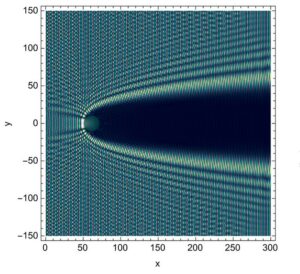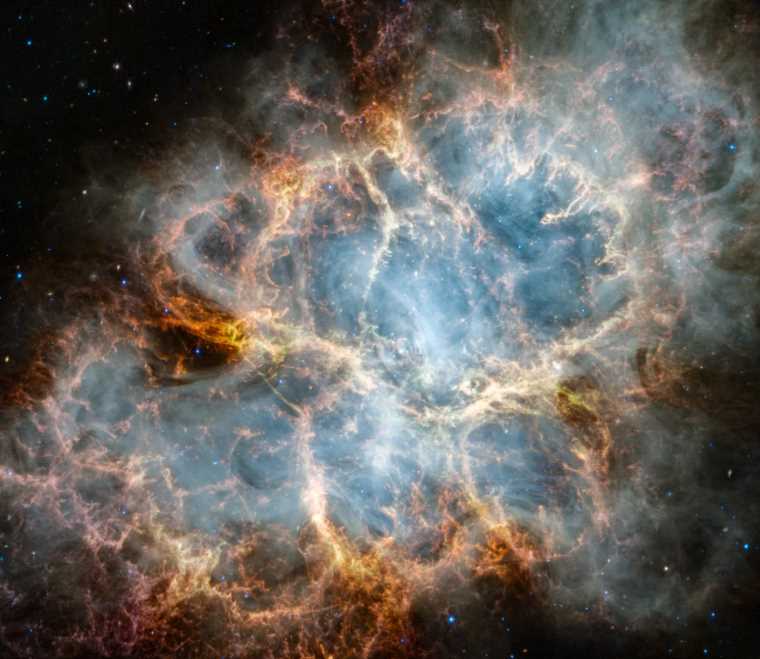A University of Kansas (KU) theoretical astrophysicist has published a possible solution to the mysterious zebra pattern in the electromagnetic (EM) signal coming from the Crab Nebula, a pattern he described as “baffling.”
The unusual zebra pattern, first detected in 2007, originates from a pulsar at the center of the Crab Nebula, over 6,000 light years from Earth. Since its discovery, researchers have struggled to explain the pattern, as it has never been detected coming from any other known pulsar.
“Researchers proposed various emission mechanisms, but none have convincingly explained the observed patterns,” explained the study’s lead author, Mikhail Medvedev, professor of physics & astronomy at KU, in a press release.
Now, Medvedev says he has found a viable solution in the pulsar’s “fringe pattern” created by EM waves passing through varying densities of plasma surrounding the pulsar. If correct, the theory could finally explain the nearly two-decade-old mystery.
Baffling Crab Nebula Signal Discovered in 2007
Pulsars are the remnants of dead stars that have gone supernova and now spin rapidly while emitting electromagnetic radiation. According to Medvedev, this emission resembles a “lighthouse beam,” which “repeatedly sweeps past Earth as the star rotates.”
“We observe this as a pulsed emission, usually with one or two pulses per rotation,” he explained.
While this pulsed emission is common to all pulsars, the theoretical astrophysicist says that the emission from the Crab Pulsar features a “zebra” pattern. According to the press release announcing the study, a zebra pattern means its electromagnetic radiation shows “unusual band spacing” that is “proportional to the band frequencies.” When viewed as a spectrum, the pattern appears striped, like the colors of a zebra.


“It’s very bright across practically all wave bands,” Medvedev explained. “This is the only object we know of that produces the zebra pattern, and it only appears in a single emission component from the Crab Pulsar.”
According to Medvedev, the main pulse coming from the pulsar at the center of the Crab Nebula is a broadband pulse, typical of most pulsars. However, he said, the “high frequency interpulse is unique” among pulsars, ranging between 5 and 30 gigahertz, or “frequencies similar to those in a microwave oven.”
Fringe Pattern Reveals Possible Solution
Unlike previous efforts to explain the mysterious zebra pattern emanating from the pulsar at the center of the Crab Nebula, Medvedev focused on a “fringe pattern” found within the pulsar’s electromagnetic emissions. This pattern contains details about the pulsar’s plasma, the “gas” of charged particles in its orbit. In Medvedev’s theory, looking at this fringe pattern through wave optics rather than the traditional geometric optics method reveals how the pulsar’s signal gets its characteristic zebra shape.
“If you have a screen and an electromagnetic wave passes by, the wave doesn’t propagate straight through,” Medvedev explained. “In geometrical optics, shadows cast by obstacles would extend indefinitely — if you’re in the shadow, there’s no light; outside of it, you see light. But wave optics introduces a different behavior — waves bend around obstacles and interfere with each other, creating a sequence of bright and dim fringes due to constructive and destructive interference.”
In Medvedev’s theory, this mechanism causes waves to bend around a gravitational source like the pulsar and “destructively interfere” with each other on the other side. When those waves try to pass through the varying densities of plasma found orbiting the pulsar, they create the once-baffling zebra pattern when they reach Earth.
“A typical diffraction pattern would produce evenly spaced fringes if we just had a neutron star as a shield,” the KU researcher said. “But here, the neutron star’s magnetic field generates charged particles constituting a dense plasma, which varies with distance from the star.”
According to Medvedev, as radio waves propagate through the ring of plasma, they are forced to pass through this uneven density. While some waves easily propagate through the less dense portions of the plasma, others are reflected by sections of dense plasma. This reflection also varies by frequency. Lower frequencies reflect waves “at large radii,” resulting in a bigger shadow, while high frequencies create smaller shadows, “resulting in different fringe spacing.”
“This model is the first one capable of measuring those parameters,” Medvedev said. “By analyzing the fringes, we can deduce the density and distribution of plasma in the magnetosphere. It’s incredible because these observations allow us to convert fringe measurements into a density distribution of the plasma, essentially creating an image or performing tomography of the neutron star’s magnetosphere.”
Approach Could Be Tested on Other Pulsars
Next, Medvedev says he wants to refine his research to consider what he described as the Crab Pulsar’s “powerful and strange gravitational and polarization effects.” The researcher says the pulsar is also relatively young and historically significant, as it was likely witnessed by Chinese scientists who “describe an unusually bright star appearing in the sky” when it went supernova in 1054.
“The Crab Pulsar is somewhat unique — it’s relatively young by astronomical standards, only about a thousand years old, and highly energetic,” he explained. “But it’s not alone; we know of hundreds of pulsars, with over a dozen that are also young.”
Medvedev says that this proposed method can also explore other known pulsars, just as pulsars allowed previous researchers to test Einstein’s general relativity theory.
“This research can indeed broaden our understanding and observation techniques for pulsars, particularly young, energetic ones,” he concluded.
The study “Origin of Spectral Bands in the Crab Pulsar Radio Emission” was published in Physical Review Letters.
Christopher Plain is a Science Fiction and Fantasy novelist and Head Science Writer at The Debrief. Follow and connect with him on X, learn about his books at plainfiction.com, or email him directly at christopher@thedebrief.org.

